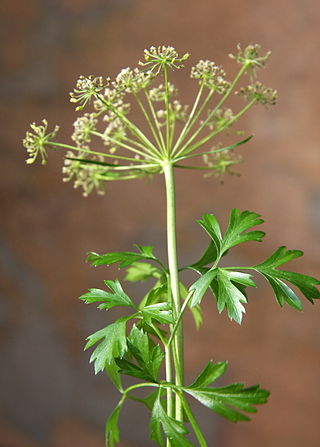
Parsley, or garden parsley is a species of flowering plant in the family Apiaceae that is native to Greece, Morocco and the former Yugoslavia. It has been introduced and naturalized in Europe and elsewhere in the world with suitable climates, and is widely cultivated as a herb, and a vegetable.

Forsythia, is a genus of flowering plants in the olive family Oleaceae. There are about 11 species, mostly native to eastern Asia, but one native to southeastern Europe. Forsythia – also one of the plant's common names – is named after William Forsyth.

Heuchera is a genus of largely evergreen perennial plants in the family Saxifragaceae. All species are native to North America except for Heuchera sichotensis, native to the Russian Far East. Common names include alumroot and coral bells.

Geranium maculatum, the wild geranium, spotted geranium, or wood geranium, is a perennial plant native to woodland in eastern North America, from southern Manitoba and southwestern Quebec south to Alabama and Georgia and west to Oklahoma and South Dakota.
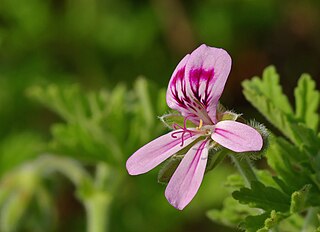
Pelargonium graveolens is a Pelargonium species native to the Cape Provinces and the Northern Provinces of South Africa, Zimbabwe and Mozambique.
The common name for the Alumroot is Coral bells. The scientific name of the Alumroot is Heuchera. The First Nations or Inuit name for the Alumroot is rat root. Alum root or Alumroot is a common name for some species of two different genera of flowering plants:

Geranium viscosissimum, commonly known as the sticky purple geranium, is a perennial in the flowering plant family Geraniaceae. It is thought to be a protocarnivorous plant.

Itea virginica, commonly known as Virginia willow or Virginia sweetspire, is a small North American flowering shrub that grows in low-lying woods and wetland margins. Virginia willow is a member of the Iteaceae family, and native to the southeast United States. Itea virginica has small flowers on pendulous racemes.

Heuchera elegans is a species of flowering plant in the saxifrage family known by the common name urn-flowered alumroot.

Heuchera maxima is a species of flowering plant in the saxifrage family, known by the common names island alum root, Channel Islands coral bells, and Jill of the rocks.

Heuchera micrantha is a species of flowering plant in the saxifrage family known by the common name crevice alumroot, or small-flowered alumroot.
× Heucherella is an evergreen perennial flowering plant in the family Saxifragaceae. A hybrid of garden origin, it is the result of a cross between two distinct genera, Heuchera and Tiarella, and shows similarities to both parents. This type of intergeneric hybrid is quite rare, and is indicated by a multiplication symbol before the name. The name Heucherella is an example of a portmanteau word, a combination of the two parents' names.
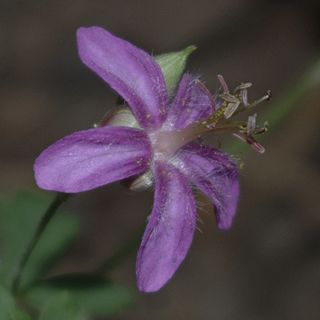
Geranium caespitosum, the purple cluster geranium or pineywoods geranium, is a perennial herb native to the western United States and northern Mexico. Its US distribution includes Arizona, Colorado, Nevada, New Mexico, Texas, Utah, and Wyoming.
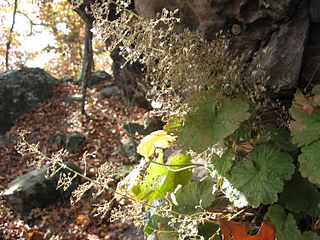
Heuchera parviflora is a species of flowering plant in the saxifrage family known by the common names cave alumroot and littleflower alumroot. It is native to the eastern United States, where it is found primarily in the Ozark Mountains, Appalachian Mountains, and Cumberland Plateau. It is found in deeply shaded areas such as under rock overhangs and cliffs, almost always where no direct sunlight falls. In this habitat, it is often the only vascular plant found. H. parviflora is an uncommon species throughout its range. It flowers in late summer through fall.

Clethra acuminata, the mountain pepper bush, is a shrub native to the Appalachian Mountains of the southeastern United States. It has been reported from the states of Pennsylvania, West Virginia, Virginia, North Carolina, South Carolina, Georgia, Alabama and Tennessee, primarily from deciduous forests at elevations of 500–1,400 m (1,600–4,600 ft).
Heuchera pulchella, the Sandia Mountain alumroot or Sandia Mountain coral-bells, is a plant species endemic to central New Mexico, mostly in the Manzano and Sandia Mountains, but cultivated as an ornamental elsewhere. It grows in canyons and on steep mountain slopes in Torrance, Bernalillo, and Sandoval Counties at elevations of 2700–3200 m.
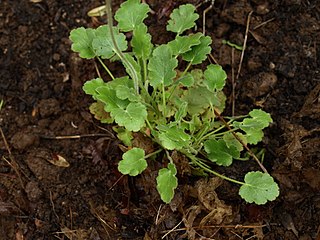
Heuchera cylindrica is a species of perennial flowering plant in the saxifrage family known by the common names poker alumroot,roundleaf alumroot, and coral bells. It is native to western North America, where it is found from British Columbia to California, and east to Wyoming and Montana.

Heuchera sanguinea, called coral bells, is a species of flowering plant in the genus Heuchera, native to the US states of Arizona and New Mexico, and to northern Mexico. A number of cultivars are commercially available. The Latin specific epithet sanguinea means blood-red, in reference to the color of the flowers. Flowers are deep pink to red, sweetly fragrant, and bell-shaped. Heuchera sanguinea is a perennial herb. The plant attracts bees and hummingbirds.
Heuchera caroliniana, the Carolina alumroot, is a species of flowering plant in the family Saxifragaceae, native to the US states of Virginia, North Carolina and South Carolina. Split off from Heuchera americana, which it closely resembles, it is found the northwestern and west-central Piedmont, where H. americana is largely absent. It grows in rich upland woods on base-saturated substrates, basic dikes, and basic rock outcroppings.


















